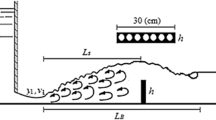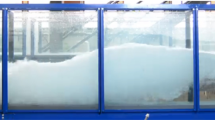Abstract
Energy dissipation structures, particularly stilling basins, are critical for defining the hydraulic jump characteristics that are suitable. Appropriate sill geometry for abruptly expanding stilling basins has been investigated and a central rectangular sill has been proposed in the literature. This study has examined the suggested central sill and alternative flip buckets for abruptly expanding stilling basins. A series of experimental and numerical studies were carried out for two different heights of the central sill and two different flip buckets. Simulations have been evaluated using experimental data of laboratory scale, which indicated that they were acceptably precise. For the simulations, the k−ε turbulence model RNG module was preferred using the volume of fluid methods. The PISO approach was chosen to resolve this equation system numerically. The results showed that the hydraulic jump characteristics are strongly influenced by sill geometry. For the Type-3 sill negative static pressures have not occurred and performs better at energy dissipation than other geometries examined in the study. Higher pressures occurred on the rectangular prism-shaped sills. Maximum static pressure happened on the Type-2 sill. The least static pressure was seen in the Type-4 sill type.













Similar content being viewed by others
Abbreviations
- θ :
-
Angle between pieces of the sills in plane view (−)
- α :
-
Expansion ratio (−)
- b :
-
Width in narrow section (L)
- B :
-
Width in wider section (L)
- g :
-
Gravity acceleration (LT−2)
- Re :
-
Reynolds number (−)
- Fr:
-
Froude number (−)
- h 1 :
-
Water depth before hydraulic jump (L)
- h 2 :
-
Water depth after hydraulic jump (L)
- h 2 * :
-
Water depth after classical hydraulic jump (L)
- L a :
-
Apron length in narrow section (L)
- L e :
-
Channel length in wider section (L)
- Lr * :
-
Roller length for classical hydraulic jump (L)
- Y :
-
Sequent depths ratio (−)
- Y * :
-
Sequent depths ratio for classical hydraulic jump (−)
- x 1 :
-
Distance between the toe of the jump and the expansion (L)
- S :
-
Relative sill height (−)
- s :
-
The sill height (L)
- U :
-
Velocity inlet (LT−1)
- ρ :
-
Fluid density (ML−3)
- τ ij :
-
Coefficient of turbulence (Reynolds) stress (−)
- k :
-
Coefficient of turbulence kinetic energy (−)
- μ t :
-
Coefficient of turbulence kinetic viscosity (−)
References
Bakhmeteff, B.M.: The hydraulic jump in terms of dynamic similarity. Trans. ASCE 101, 630–680 (1936)
Bradley, J.; Peterka, A.: The hydraulic design of stilling basins: hydraulic jumps on a horizontal apron (basin i). J. Hydraul. Div. 83(5), 1–24 (1957)
Rajaratnam, N.; Murahari, V.: A contribution to forced hydraulic jumps. J. Hydraul. Res. 9(2), 217–240 (1971)
Hager, W.H.: Hydraulic jump in non-prismatic rectangular channels. J. Hydraul. Res. 23(1), 21–35 (1985)
Hager, W.H.: Hydraulic jump in U-shaped channel. J. Hydraul. Eng. 115(5), 667–675 (1989)
Gharangik, A.M.; Chaudhry, M.H.: Numerical simulation of hydraulic jump. J. Hydraul. Eng. 117(9), 1195–1211 (1991)
Bremen, R.; Hager, W.H.: T-jump in abruptly expanding channel. J. Hydraul. Res. 31(1), 61–78 (1993)
Bremen, R.; Hager, W.H.: Expanding stilling basin. Proc. Inst. Civ. Eng.-Water Maritime Energy 106(3), 215–228 (1994)
Zare, H.; Doering, J.: Forced hydraulic jumps below abrupt expansions. J. Hydraul. Eng. 137(8), 825–835 (2011)
Deng, J., et al.: Analysis of pressure differences and water transverse movement in a partial-flip bucket. J. Hydraul. Eng. 146(9), 04020063 (2020)
Juon, R.; Hager, W.H.: Flip bucket without and with deflectors. J. Hydraul. Eng. 126(11), 837–845 (2000)
Tian, R.; Wu, J.-H.; Ma, F.: Flow regime and energy dissipation of SFS-type flip buckets. J. Hydrodyn. 32(1), 179–182 (2020)
Heller, V.; Hager, W.H.; Minor, H.-E.: Ski jump hydraulics. J. Hydraul. Eng. 131(5), 347–355 (2005)
Moghadam, M.K.; Amini, A.; Hosseini, H.: Experimental evidence dynamic pressures reduction on plunge pool floors downstream flip bucket for increasing downstream face slopes. Water Supply 20(5), 1834–1846 (2020)
Parsaie, A.; Azamathulla, H.M.; Haghiabi, A.H.: Prediction of discharge coefficient of cylindrical weir–gate using GMDH-PSO. ISH J. Hydraul. Eng. 24(2), 116–123 (2018)
Chanson, H.; Brattberg, T.: Experimental study of the air–water shear flow in a hydraulic jump. Int. J. Multiph. Flow 26(4), 583–607 (2000)
Dey, S.; Nath, T.K.; Bose, S.K.: Submerged wall jets subjected to injection and suction from the wall. J. Fluid Mech. 653, 57–97 (2010)
Ohtsu, I.: Free Hydraulic Jump and Submerged Hydraulic Jump in Trapezoidal and Rectangular Channels. Japan Society of Civil Engineers, Tokyo (1976)
Torkamanzad, N., et al.: Hydraulic jump below abrupt asymmetric expanding stilling basin on rough bed. Water 11(9), 1756 (2019)
Chachereau, Y.; Chanson, H.: Free-surface fluctuations and turbulence in hydraulic jumps. Exp. Thermal Fluid Sci. 35(6), 896–909 (2011)
Felder, S.; Pfister, M.: Comparative analyses of phase-detective intrusive probes in high-velocity air–water flows. Int. J. Multiph. Flow 90, 88–101 (2017)
Mouaze, D.; Murzyn, F.; Chaplin, J.R.: Free surface length scale estimation in hydraulic jumps. ASME J. Fluids Eng. 127(6), 1191–1193 (2005). https://doi.org/10.1115/1.2060736
Zhang, G.; Chanson, H.: Air-water flow properties in stepped chutes with modified step and cavity geometries. Int. J. Multiph. Flow 99, 423–436 (2018)
Demirel, E.: Measured and simulated flow downstream of the submerged sluice gate. Water Environ. J. 29(3), 446–455 (2015)
Javan, M.; Eghbalzadeh, A.: 2D numerical simulation of submerged hydraulic jumps. Appl. Math. Model. 37(10–11), 6661–6669 (2013)
Ma, F.; Hou, Y.; Prinos, P.: Numerical calculation of submerged hydraulic jumps. J. Hydraul. Res. 39(5), 493–503 (2001)
Jesudhas, V., et al.: Closure to “turbulence characteristics of classical hydraulic jump using DES” by Vimaldoss Jesudhas, Ram Balachandar, Vesselina Roussinova, and Ron Barron. J. Hydraul. Eng. 146(9), 07020012 (2020)
Witt, A.; Gulliver, J.S.; Shen, L.: Numerical investigation of vorticity and bubble clustering in an air entraining hydraulic jump. Comput. Fluids 172, 162–180 (2018)
Foda, A.S., et al.: Three-dimensional numerical study of submerged spatial hydraulic jumps. J. Hydrol. Hydromech. 68(3), 211–222 (2020)
Jesudhas, V.; Balachandar, R.; Bolisetti, T.: Numerical study of a symmetric submerged spatial hydraulic jump. J. Hydraul. Res. 58(2), 335–349 (2020)
Jesudhas, V., et al.: Turbulence characteristics of classical hydraulic jump using DES. J. Hydraul. Eng. 144(6), 04018022 (2018)
Riasi, A.; Nourbakhsh, A.; Raisee, M.: Energy dissipation in unsteady turbulent pipe flows caused by water hammer. Comput. Fluids 73, 124–133 (2013)
Li, L.-X., et al.: Experimental investigation of the optimization of stilling basin with shallow-water cushion used for low Froude number energy dissipation. J. Hydrodyn. 27(4), 522–529 (2015)
Zhang, Q.-L., et al.: Role of negative pressure in structural responses of gravity dams to underwater explosion loadings: the need to consider local cavitation. Eng. Fail. Anal. 122, 105270 (2021)
Novak, P., et al.: Hydraulic Modelling: An Introduction: Principles, Methods and Applications. CRC Press, Boca Raton (2018)
Akoz, M.S.; Kirkgoz, M.S.; Oner, A.A.: Experimental and numerical modeling of a sluice gate flow. J. Hydraul. Res. 47(2), 167–176 (2009)
Yakhot, V., et al.: Development of turbulence models for shear flows by a double expansion technique. Phys. Fluids A 4(7), 1510–1520 (1992)
Shaari, K.Z.K.; Awang, M.: Engineering Applications of Computational Fluid Dynamics. Springer, Berlin (2015)
Hirt, C.W.; Nichols, B.D.: Volume of fluid (VOF) method for the dynamics of free boundaries. J. Comput. Phys. 39(1), 201–225 (1981)
Gumus, V., et al.: Numerical modeling of submerged hydraulic jump from a sluice gate. J. Irrig. Drain. Eng. 142(1), 04015037 (2016)
Ohtsu, I.; Yasuda, Y.; Ishikawa, M.: Submerged hydraulic jumps below abrupt expansions. J. Hydraul. Eng. 125(5), 492–499 (1999)
Zare, H.K.; Baddour, R.E.: Three-dimensional study of spatial submerged hydraulic jump. Can. J. Civ. Eng. 34(9), 1140–1148 (2007)
Roache, P.J.: Verification of codes and calculations. AIAA J. 36(5), 696–702 (1998)
Herbrand, K.: The spatial hydraulic jump. J. Hydraul. Res. 11(3), 205–218 (1973)
de Dios, M., et al.: Experimental characterization of three-dimensional flow vortical structures in submerged hydraulic jumps. J. Hydro-Environ. Res. 15, 1–12 (2017)
Acknowledgements
This research was supported by IUBAP (Inonu University Scientific Projects Unit) under the project number of the FBG-2020-2186.
Author information
Authors and Affiliations
Corresponding author
Rights and permissions
About this article
Cite this article
Aydogdu, M., Gul, E. & Dursun, O.F. Experimentally Verified Numerical Investigation of the Sill Hydraulics for Abruptly Expanding Stilling Basin. Arab J Sci Eng 48, 4563–4581 (2023). https://doi.org/10.1007/s13369-022-07089-6
Received:
Accepted:
Published:
Issue Date:
DOI: https://doi.org/10.1007/s13369-022-07089-6




